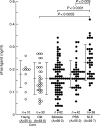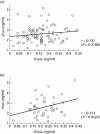Serum levels of soluble Fas ligand in patients with silicosis
- PMID: 10594565
- PMCID: PMC1905452
- DOI: 10.1046/j.1365-2249.1999.01083.x
Serum levels of soluble Fas ligand in patients with silicosis
Abstract
Certain patients with silicosis have been reported to exhibit immunological abnormalities such as the appearance of antinuclear antibodies and the occurrence of autoimmune diseases. Fas ligand (FasL) is a type II membrane protein which induces apoptosis by binding to its membrane receptor, Fas. FasL is converted to a soluble form by a metalloproteinase-like enzyme. We have already found serum soluble Fas (sFas) levels in silicosis patients as well as in patients with systemic lupus erythematosus (SLE) to be significantly higher than those in healthy volunteers. To examine further the role of the Fas/FasL system in silica-induced immunological abnormalities, we investigated serum soluble FasL (sFasL) levels in silicosis patients with no clinical symptoms of autoimmune diseases, using ELISA for sFasL. Although the serum sFasL levels in patients with SLE were significantly higher than those in healthy volunteers and showed a slight positive correlation with serum sFas levels, those in silicosis patients exhibited no significant difference from those in healthy volunteers, and there was no correlation with serum sFas levels. However, sFasL levels were elevated in silicosis patients with slight dyspnoea or normal PCO2 among various clinical parameters of silicosis. It may be speculated that the immunological disturbances presented by the abnormalities of apoptosis-related molecules in silicosis patients do not occur with a similar degree of respiratory involvement. Further studies are required to clarify which kinds of factors are involved in silicosis patients who exhibit immunological abnormalities.
Figures


References
-
- Haustein UF, Ziegler V, Herrmann K, Mehlhorn J, Schmidt C. Silica-induced scleroderma. J Am Acad Dermatol. 1990;22:444–8. - PubMed
-
- Rustin MH, Bull HA, Ziegler V, Mehlhorn J, Haustein UF, Maddison PJ, James J, Dowd PM. Silica-associated systemic sclerosis is clinically, serologically and immunologically indistinguishable from idiopathic systemic sclerosis. Br J Dermatol. 1990;123:725–34. - PubMed
-
- Uber CL, McReynolds RA. Immunotoxicology of silica. Crit Rev Toxicol. 1982;10:303–19. - PubMed
-
- Haslam PL. Parkes WR. Occupational lung disorders. 3. London: Butterworth Heinemann; 1994. Basic immunology and immunopathology; pp. 50–99.
Publication types
MeSH terms
Substances
LinkOut - more resources
Full Text Sources
Research Materials
Miscellaneous

